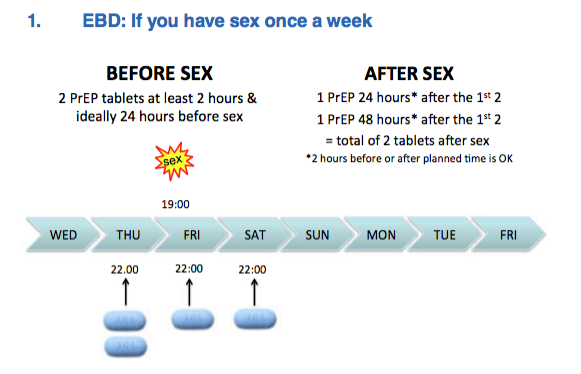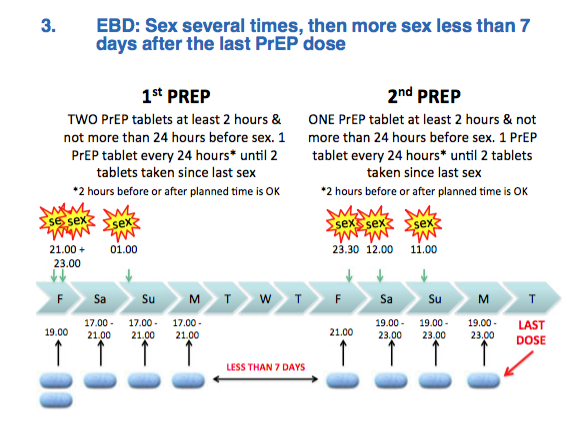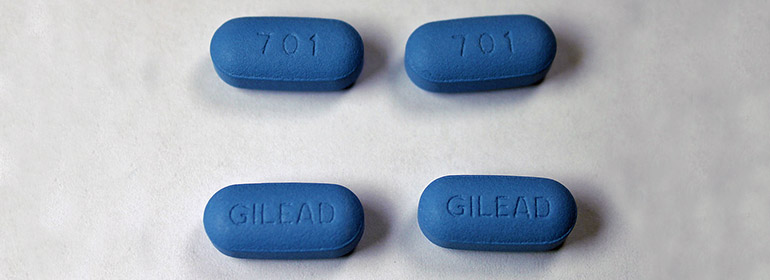From simple questions like what is PrEP to information about where to get it, this is the PrEP guide you need to read if you’re considering taking the HIV preventing medication
What is PrEP?
PrEP means Pre-Exposure Prophylaxis. This is the use of anti-HIV medication that prevents HIV-negative people from becoming infected with the virus. One such PrEP medication is Truvada.
When taken once a day, Truvada is highly successful (between 92% and 99% successful according to prepfacts.org) at preventing HIV from being contracted.
By taking Truvada once a day prior to coming in contact with HIV, the chances of contracting the virus are significantly reduced.
There are two medicines in Truvada: emtricitabine and tenofovir disoproxil fumarate, which both act together to prevent HIV-1 from taking hold in the body of HIV-negative people.
Truvada does not prevent HIV-2 from being acquired, however this subtype of HIV is found primarily in Africa.
Truvada is also used to treat people who are HIV-positive, but the dosage of active ingredients is different.
Who can take PrEP?
PrEP can be taken by HIV-negative people who are at risk of contracting HIV, such as: those engaging in condomless sex; those whose partners are HIV-positive and on anti-retroviral therapy (ART) with undetectable viral loads and those who exchange sex for commodities (money, food, shelter or drugs).
Where can you get PrEP in Ireland?
Truvada has been approved in Ireland as part of PEP but not as part of PrEP.
The Irish government has yet to assess the safety and efficacy of Truvada when used for PrEP, so it is not currently widely available in Ireland for that purpose.
Although a doctor can write a prescription for PrEP in Ireland, it is not currently legal to buy PrEP directly in Ireland.
As a workaround, Dr Will Nutland outlines that it is legal to purchase three months of PrEP for personal use to be delivered to a UK or Northern Ireland address and collect it, or have it forwarded on to you.
Dr Nutland is the co-founder of PrEPster, a company which aims to educate and agitate for PrEP access.
What is PEP?
PEP (Post-Exposure Prophylaxis) means taking anti-retroviral medicines after potentially being exposed to HIV to prevent becoming infected with the virus.
The medicines used for PEP include Truvada and another anti-HIV medication which work together to stop HIV from taking hold in the body.
PEP can be started up to 72 hours after a potential exposure to HIV and is used for one month following a potential exposure to HIV. If PEP is started within 72 hours, it is highly successful at preventing HIV from being acquired.
If you believe you have come in contact with HIV and are looking to take PEP as quickly as possible, visit an STI clinic or an emergency department within 72 hours to be supplied with the medication.
Are there any PrEP trials taking place in Ireland that I can be part of?
As of December 2016, there is one PrEP trial which is seeking participants. The study is taking place in Dublin and is being run by UCD and The Mater Hospital.
The purpose of this study is to measure the effectiveness of a new drug with a similar active ingredient as Truvada.
In Truvada (F/TDF) the drugs emtricitabine (F) and tenofovir disoproxil fumarate (TDF) are the active ingredients. The new drug F/TAF, which combines drugs emtricitabine (F) and tenofovir alafenamide (TAF), is being trialled for use as PrEP.
For more information on F/TAF and this new Irish PrEP study check out the details here.
When do you take PrEP?
PrEP is taken once a day, continually for at least seven days (30 days is recommended) before the drug has built up enough in your system to prevent HIV from being contracted.
Taking PrEP at the same time every day ensures that the active ingredients are consistently in your body, providing the most protection against contracting HIV.
How does PrEP work?
Aidsmap.com explain how the PrEP medication works:
“The principle of PrEP is similar to that of antimalarial tablets used to prevent malaria when travelling in tropical countries.
“Somebody who does not have HIV takes enough antiretrovirals (ARVs) for there to be high levels of the drugs in their bloodstream, genital tract and rectum before any exposure to HIV. If exposure occurs, the ARVs stop the virus from entering cells and replicating. This prevents HIV from establishing itself and the person remains HIV negative.”
Truvada was selected because the drugs in the pill have “limited side-effects, have few problems with drug resistance, reach high levels in the genital tract and rectum, and remain in the body for a relatively long time.”
Here’s a video that explains the way the PrEP protects the body against HIV.
What is PrEP? from Pre-Exposure Prophylaxis on Vimeo.
Side Effects
Side effects from taking PrEP include headaches, nausea, vomiting and diarrhoea which tend to go away after the first three to four weeks of taking PrEP for most people who suffer them.
i-Base explained that only 10% of people taking PrEP experience these side effects.
“Mild nausea, diarrhoea, bloating and headache were reported in the first month by less than 1 in 10 people. These side effects then usually stop,” their information leaflet reads.
Another possible side effect of PrEP is a small reduction in bone mineral density (BMD) in young adults. This usually occurs within one month of starting PrEP, however the reduction is small (between 0.85% and 1.5% according to a study) and does not progress over time.
After PrEP is stopped, a further study on the BMD of young adults with an average age of 29 revealed that BMD measured in both the spine and hip had fully returned to normal after 73 weeks.
Combination anti-retroviral therapy required for treatment of HIV-positive people causes a more significant loss in BMD than PrEP, the authors of the first study noted.
Increased kidney function is another potential side effect of PrEP, which can cause kidney problems, or kidney failure. Kidney function can and should be monitored on a regular basis while taking PrEP.
Serious liver problems are cited on the Truvada website as another possible side effect, along with an enlarged and tender liver, or the development of fat in the liver, being possible.
Lactic acidosis, or too much lactic acid in your blood, is another serious potential side effect of Truvada, which should be treated as a medical emergency should symptoms arise. According to the Truvada website, symptoms include “weakness or being more tired than usual, unusual muscle pain, being short of breath or fast breathing, nausea, vomiting, stomach-area pain, cold or blue hands and feet, feeling dizzy or lightheaded, and/or fast or abnormal heartbeats.”
If you already have Hepatitis-B, this may worsen as a side effect after you stop taking PrEP.
Changes in body fat are another listed side-effect of Truvada, with weight loss listed as common side effect.
Why would people take PrEP when there are other methods of protection against HIV?
While physical barriers like condoms and dental dams provide a similar level of protection from HIV, this presumes that condoms are a part of people’s plan to reduce risk when it comes to sexual practices, are used consistently and correctly, and do not suffer from slippages or breaks.
Nearly one in ten who did not receive PrEP in the PROUD study became infected with HIV within one year. This indicates that a non-negligible section of the MSM community are not sufficiently protected with current measures of HIV prevention like condoms, since one new HIV diagnosis is being made every eighteen hours in Ireland according to Act Up Dublin (add link).
While efforts to improve safe sex awareness and practices are important and must continue, taking PrEP can provide an additional level of protection against HIV. Other methods of reducing risk of HIV include sero-sorting or reducing the number of sexual partners.
You Should Not Use PrEP If…
You should not use PrEP if you already have HIV-1. While Truvada is effective at preventing HIV being transmitted, it is not sufficient to treat HIV-positive patients. Further, if a HIV-positive person takes PrEP, the virus may become resistant to the medication, which is why it is really important to ensure that you are HIV-negative before and during PrEP.
You should also not use PrEP if you are taking any of the following:
- Medicines containing emtricitabine, tenofovir alafenamide, or tenofovir disoproxil fumarate (ATRIPLA, COMPLERA, DESCOVY, EMTRIVA, GENVOYA, ODEFSEY, STRIBILD, VIREAD).
- Medicines containing lamivudine (Combivir, Dutrebis, Epivir, Epivir-HBV, Epzicom, Triumeq, Trizivir).
- Medicines containing adefovir (HEPSERA).
Resistant HIV strains
While Truvada does not protect against the HIV-2 subgroup of HIV, there are strains of the HIV-1 virus which have developed a resistance to the drugs in PrEP.
I-Base indicated that in February 2016 there was a case reported of a man who became infected with HIV even though he was taking PrEP daily.
“This was because they caught HIV from a partner who was already resistant to the drugs in PrEP,” the i-Base guide indicates, highlighting the importance of ensuring that you are HIV-negative before starting PrEP.
“Currently, drug resistance to tenofovir DF and emtricitabine is very uncommon in the UK.”
Will PrEP Protect Against Other STIs?
No, PrEP will not protect against other STIs such as chlamydia, gonorrhoea or syphilis. In order to successfully minimise your risk of acquiring STIs, use PrEP alongside other safer-sex practices such as using condoms and limiting your number of sex partners.
As regular monitoring is required when taking PrEP, be sure to test for other STIs when visiting an STI clinic, since some STIs are symptomless.
Do I Have To Take PrEP Every Day?
While a lot of study has been done on daily Truvada use, and it is believed this provides the highest level of protection, there is evidence that Event Based Dosing (EBD) is effective in preventing HIV from being contracted.
The IPERGAY study examined PrEP’s effectiveness when taken prior to and immediately following sex, a dosing method which proved to be 86% effective at preventing HIV from being contracted.
How Do I Take PrEP For EBD?
For EBD, the dose is as follows. Take two pills before sex (ideally 24 hours before sex, but between 24 and 2 hours before sex was used in the study) as a double dose followed by a single pill 24 hours later and another single pill 48 hours after sex.
If sex continues, then take one pill each day until 48 hours after sex stops.
i-Base have given the following examples of the timing when taking PrEP for EBD.



EBD is unsuitable for women having vaginal sex, owing to the medication not getting into vaginal tissues as well as it gets into rectal tissue. It is also not recommended for people with Hep-B.
Do you have any other questions about PrEP? Let us know in the comments below.
Image: By Jeffrey Beall (Own work) [CC BY-SA 3.0], via Wikimedia Commons
© 2016 GCN (Gay Community News). All rights reserved.
